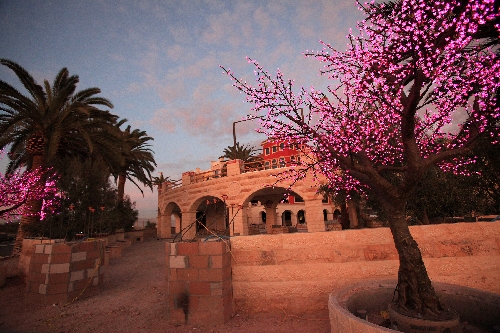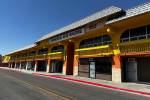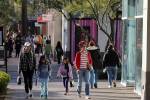Retail market still struggling in Southern Nevada
Drive by just about any shopping center in Las Vegas and you'll see shuttered storefronts, going-out-of-business sales and banners advertising space available for lease.
It doesn't take a chief economist to tell us that retailers are hurting in Las Vegas and commercial real estate is in the tank. The skeletal steel framework of General Growth Properties' stalled Summerlin mall project stands in testament of that.
Tumbling home values and rising unemployment put the skids on consumer spending, and perhaps no city felt the shock wave more than Las Vegas.
Taxable sales in Clark County fell by double-digit percentages in 2009, though they had increased 2.7 percent to more than $9.3 billion through October, the Nevada Department of Taxation reported.
Las Vegas-based business advisory firm Applied Analysis showed local retail vacancy climbed from 4 percent in 2005 to slightly above 10 percent at the end of last year.
The retail sector is in serious trouble, said Jeffrey Taylor, a management consultant and author based in Tucson, Ariz.
Retailers appear to have overestimated consumers' spending momentum and are reporting December sales numbers that show the poor economy still has the upper hand, he said.
That's not what the National Retail Federation reported. Preliminary 2010 holiday sales, which combine the full months of November and December, rose 5.7 percent to $462 billion, surpassing the federation's forecast of 3.3 percent. This represents the best holiday sales gain since 2004, when holiday sales increased 5.9 percent.
Target Corp. announced that lower-margin items drove a higher portion of sales than expected. Sales of some key gift items shifted earlier into November. J.C. Penney Co. exceeded expectations, posting 3.7 percent same-store sales growth.
Same-store sales are sales at stores open at least a year. Economists consider them an important measure of a retailer's health.
Online commerce might be hurting brick-and-mortar shops. Taylor went to Home Depot, Lowe's and The Great Indoors to look at appliances and fixtures for his new home. He wrote down model numbers and then went online to get better prices. Even with shipping, he saved anywhere from 15 percent to 35 percent on luxury items.
"It's killing retail because you've got third-party suppliers that are buying surplus inventory," Taylor said. "It's the Internet version of the 99-cent store. Retailers have to lower prices on commodities and that puts more pressure on retail. You begin to realize there's no end in sight.
"Although I feel sorry for the local stores and the salespeople, I do not believe that God would have invented the Internet if he did not want me to use it," he said.
Retail analyst Brian Sozzi of New York-based Wall Street Investments said he's hearing mixed messages on same-store sales for December and disappointing fourth-quarter earnings reports. That sent the Standard & Poor's Retail Index down.
The pullback amidst the broader market's lingering bullishness is indicative of a more realistic view of the U.S. consumer recovery, Sozzi said.
"When a Family Dollar reports store traffic was up 7 percent in the quarter, it's a sign that low-income consumers are struggling with higher prices on staples, gasoline and job prospects," he said. "Until traffic at dollar stores begins to soften, how can we say with a degree of confidence the consumer is alive and kicking emphatically?"
The commercial retail downturn has been tied to both the local economy and movements in the national economy, Applied Analysis principal Brian Gordon said.
From a local perspective, Southern Nevada continues to experience record-setting unemployment, foreclosure activity, bankruptcies and depressed consumer spending.
"The decline in consumer spending has been dramatic in recent years, but these comparisons are generally made to unsustainable peak levels that were fueled partially by home-equity extractions," Gordon said. "When taking out the ups and downs in the latest cycle, consumer spending appears to be trending more in line with long-run historical averages."
Even as retail vacancy rose, developers built more shopping centers and big-box stores in Las Vegas, pushing retail inventory from almost 42 million square feet to 51.2 million square feet in five years, Applied Analysis reported.
"The problem is many retailers built their business around consumer spending patterns that emerged during the 2003 to 2006 time frame," Gordon said. "As retailers were looking for expansion opportunities, the development community responded with new centers, sometimes located where residential development activity was expected.
"When the music stopped," he added, "newer retail centers struggled as the rooftops didn't arrive in mass quantities like expected."
Some of those properties are
going back to the bank, part of the
$3.5 trillion in commercial loan losses that many analysts predicted would dwarf residential mortgage defaults. Las Vegas has seen its share of prominent retail developments go into foreclosure, including Town Square on Las Vegas Boulevard and land that was planned for the Great Mall of Las Vegas.
"We actually take in a lot of retail, a lot of bank-owned stuff," broker Frank Gatski of Gatski Commercial said. "It's going to keep on coming. More assets are going back to the bank."
Much of the real estate-owned, or bank-owned, commercial property was built during the heyday of new development, around 2004 and 2005, Gatski said. They were overleveraged and couldn't be leased from the time they were built, he said.
"Those are the first ones coming back to the bank," Gatski said. "But I'll tell you, at the first of the year we got an established retail center with an anchored tenant. That's the first one I've seen go into REO with 85 percent occupancy."
Despite doom-and-gloom predictions, very little distressed commercial real estate came onto the market in 2010. That will change this year, Colliers International chief economist Ross Moore said.
Distressed property accounted for less than 10 percent of total sales in early 2010, but recent data shows troubled real estate assets now make up 15 percent of total transactions and could account for as much as 20 percent to 25 percent of sales early this year, Moore said.
He attributes that to a combination of factors, including federal regulators, price discovery, more liquid markets, and legal and fiduciary issues associated with distressed properties.
With the banking sector showing signs of stabilizing, the "extend and pretend" phenomenon is expected to taper off, Moore said. "Extend and pretend" is a common strategy banks use to restructure troubled commercial loans, rather than foreclose on a property, in hopes the borrower can get back on his feet.
Nobody really knows whether the commercial foreclosure wave is coming, but retail properties in Las Vegas are definitely going back to the bank, retail broker Mike Zobrist of Grubb & Ellis said. Anything built from 2007 to 2010 with pro forma rent of $2.50 to $2.70 a square foot is likely in default, he said.
Zobrist is working to fill Silverado Ranch Village, which was only 40 percent occupied when it was bought out of foreclosure for $7.9 million. It's now more than 90 percent occupied.
"Those are the types of things happening in the market, and as brokers, there's stuff out there," Zobrist said. "We need to get that stuff and turn it over."
Overpriced rent was the main barrier to entry for many retailers wanting to come to Las Vegas in the past, he said. Discount and convenience store operators are looking at space for $1.85 a square foot with 3 percent year-over-year increase, though some pockets are getting $2.50 to $4.50 a square foot, Zobrist said.
Tivoli Village at Queensridge is in that high-rent district. The first phase of the $800 million mixed-use development at Rampart Boulevard and Alta Drive is scheduled to open in March, bringing about 225,000 square feet of retail to the market.
The collective mix of retailers and restaurants that have already signed leases at Tivoli Village makes it "a true destination center," Executive Vice President Patrick Done said.
They include Charming Charlie, Tivoli Irish Pub, Petra Greek Restaurant, Roc Republic of Couture, Obika Sunglasses, Kidville, Brio Tuscan Grille, Vasari, Candy Elephant, Stash, Ratskeller, Pesci's Pizza, Corsa lifestyle boutique and Ritual Salon and Spa.
Tivoli Village, with its custom stonework and old European village-style architecture, is across the street from Boca Fashion Village, an upscale shopping center built by Triple Five Development that went into foreclosure in 2009.
IDB Group and EHB Cos., developers of Tivoli Village and One Queensridge Place, bought 23 acres of bank-owned land at Boca Park for $11.8 million last year and plan to build a pedestrian overpass connecting Tivoli to Boca.
Grubb & Ellis research director Dave Dworkin said small retailers are having difficulty staying in business, especially those who signed three- or five-year leases before the recession hit.
Over the last two years, several grocery or big-box centers lost their anchors and vacancy in those centers surged, Dworkin said. While downsizing by larger tenants started to ease toward the end of 2010, the damage to those centers has already been done.
A common practice in 2010 was for tenants to sign new leases with their landlords rather than renew existing leases. Even in a saturated retail market, new retail tenants can take advantage of the recession and lock into rock-bottom rates for years ahead, Dworkin said.
"Vegas needs tenants that aren't already here to bring in something fresh," he said. "They don't have to open 20 stores. Try one."
Contact reporter Hubble Smith at hsmith@reviewjournal.com or 702-383-0491.




























